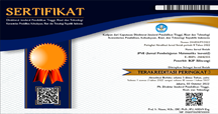Kemampuan pemahaman matematis siswa MTs pada materi statistika ditinjau berdasarkan teori Newman
DOI:
https://doi.org/10.22460/jpmi.v7i1.20733Keywords:
Mathematical Understanding Ability, Statistics, NewmanAbstract
The purpose of this study was to determine the extent to which students solve problems in mathematical understanding skills in statistics material. The method in this study is descriptive qualitative and data collection is given 3-point statistics questions in the form of descriptions. The research subjects were class VIII which amounted to 6 people. The results of the researcher's analysis show that mathematical understanding ability is still low in statistics material. Some of the difficulties experienced by students are that students still have difficulty reading the questions given, students' ability to understand the problem is still lacking, students' difficulty in writing the formula given, students' lack of accuracy in prerequisite material, students answer questions carelessly, so students do not solve the problem correctly. Difficulties in this study can be caused by students not paying attention to the teacher's explanation and even still lacking accuracy in understanding the problem, reading questions in the form of description questions, the way students think about mathematics comprehension skills is still difficult. Therefore, it is necessary to have an improvement and follow-up in future research to improve students' mathematical understanding ability in statistics material or better yet, it can replace other materials.
References
Aida, N., Kusaeri, K., & Hamdani, S. (2017). Karakteristik instrumen penilaian hasil belajar matematika ranah kognitif yang dikembangkan mengacu pada model PISA. Suska Journal of Mathematics Education, 3(2), 130. https://doi.org/10.24014/sjme.v3i2.3897
Aini, K. N., Matematika, P., & Malang, P. N. (2016). Proses koneksi matematika siswa. Jurnal Pendidikan: Teori, Penelitian, Dan Pengembangan, 1(3), 377–388. http://dx.doi.org/10.17977/jp.v1i3.6164
Alzanatul Umam, M., & Zulkarnaen, R. (2022). Analisis kemampuan pemahaman konsep matematis siswa dalam materi sistem persamaan linear dua variabel. Jurnal Educatio FKIP UNMA, 8(1), 303–312. https://doi.org/10.31949/educatio.v8i1.1993
Anggraini, Y. P., & Kartini, K. (2020). Analisis kesalahan siswa dalam menyelesaikan soal persamaan kuadrat pada siswa kelas IX SMPN 2 Bangkinang Kota. AXIOM : Jurnal Pendidikan Dan Matematika, 9(2), 210. https://doi.org/10.30821/axiom.v9i2.7682
Aripin, U. (2015). Meningkatkan kemampuan pemahaman matematik siswa smp melalui pendekatan pembelajaran berbasis masalah. P2M STKIP Siliwangi, 2(1), 120. https://doi.org/10.22460/p2m.v2i1p120-127.171
Bernard, M., Sumarna, A., Rolina, R., & Akbar, P. (2019). Development of high school student work sheets using VBA for microsoft word trigonometry materials. Journal of Physics: Conference Series, 1315(1). https://doi.org/10.1088/1742-6596/1315/1/012031
Cahani, K., Effendi, K. N. S., & Munandar, D. R. (2021). Kemampuan pemahaman konsep matematika siswa ditinjau dari konsentrasi belajar pada materi statistika dasar. Pembelajaran Matematika Inovatif, 4(1), 215–224. https://doi.org/10.22460/jpmi.v4i1.215-224
Dewi, D. K., Khodijah, S. S., & Zanthy, L. S. (2020). Analisis kesulitan matematik siswa SMP pada materi statistika. Jurnal Cendekia : Jurnal Pendidikan Matematika, 4(1), 1–7. https://doi.org/10.31004/cendekia.v4i1.148
Febriana, E. (2015). Profil kemampuan spasial siswa menengah pertama (SMP) dalam menyelesaikan masalah geometri dimensi tiga ditinjau dari kemampuan matematika. Jurnal Elemen, 1(1), 13. https://doi.org/10.29408/jel.v1i1.78
Nugaha, N., Kadarisma, G., & Setiawan, W. (2019). Analisis kesulitan belajar matematika dalam materi bangun datar pada siswa SMP kelas VII. Journal On Education, 01(02), 323–334. http://jonedu.org/index.php/joe/article/view/72/59
Purwasih, R. (2015). Peningkatan kemampuan pemahaman matematis dan self confidence siswa MTs di Kota Cimahi melalui model pembelajaran inkuiri terbimbing. Jurnal Ilmiah STKIP Siliwangi Bandung, 9(1), 16–25. http://e-journal.stkipsiliwangi.ac.id/index.php/didaktik/article/view/113
Rosmawati, R. R., & Sritresna, T. (2021). Kemampuan pemahaman konsep matematis ditinjau dari self-confidence siswa pada materi aljabar dengan menggunakan pembelajaran daring. Plusminus: Jurnal Pendidikan Matematika, 1(2), 275–290. https://doi.org/10.31980/plusminus.v1i2.1261
Sesanti, N. R., & Bere, M. G. S. (2020). Analisis kesulitan siswa kelas III sekolah dasar dalam penyelesaian masalah matematika bentuk soal cerita berdasarkan teori newman. Jurnal Inovasi Penelitian, 1(7), 1559–1464. https://doi.org/10.47492/jip.v1i7.264
Sunardiningsih, G. W., Hariyani, S., & Fayeldi, T. (2019). Analisis kesalahan siswa dalam menyelesaikan soal matematika berdasarkan analisis Newman. RAINSTEK : Jurnal Terapan Sains & Teknologi, 1(2), 41–45. https://doi.org/10.21067/jtst.v1i2.3447
Tianingrum, R., & Sopiany, H. N. (2017). Analisis kemampuan pemahaman matematis siswa. Analisis Kemampuan Pemahaman Matematis Siswa, 440–446. http://pmat-unsika.eu5.org/Prosiding/64RisnaTianingrum-Sesimodika-2017.pdf
Wulansari, T., Putra, A., Rusliah, N., & Habibi, M. (2019). Pengaruh model pembelajaran berbasis masalah pada materi statistika terhadap kemampuan penalaran statistik siswa. AKSIOMA : Jurnal Matematika Dan Pendidikan Matematika, 10(1), 35–47. https://doi.org/10.26877/aks.v10i1.3647
Downloads
Published
Issue
Section
License

This work is licensed under a Creative Commons Attribution-ShareAlike 4.0 International License.
The author is responsible for acquiring the permission(s) to reproduce any copyrighted figures, tables, data, or text that are being used in the submitted paper. Authors should note that text quotations of more than 250 words from a published or copyrighted work will require grant of permission from the original publisher to reprint. The written permission letter(s) must be submitted together with the manuscript.
















